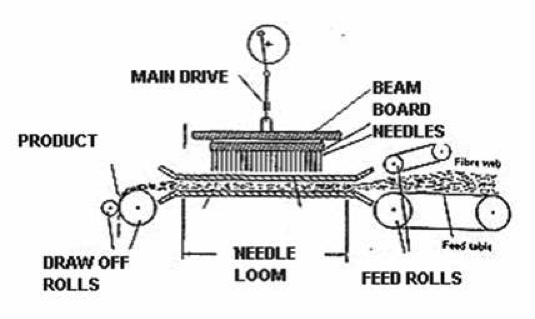Continuing our “How It’s Made Series,” today we’ll discuss how nonwoven needlepunch fabrics are made from webs of fibers (to see the web-making process, check out our carding/airlaid blog post). In the case of needlepunch, some of the fibers have been driven through the web by—yep, you guessed it—barbed needles. This gives the webs strength by mechanically bonding the fibers together, ultimately forming a durable and cohesive fabric.
Explaining How the “Needle” in Needlepunch Works
The barbed needles penetrate the web, grabbing fibers from the top and pushing them through the bottom. When the needles retract, the fibers are left in the vertical position, giving the web (i.e., the fabric) strength via the entangled fibers. The two graphics below illustrate this aspect of the process.


The needles are placed on a board that is the width of the web. Note that thousands of needles are employed in a board, and that the board is pushed up and down through the web as it moves by. The number of punches in the web is controlled by the frequency of the up-and-down motion of the needle board. The frequency can range from 800 to 2500 strokes per minute. The more strokes, the stronger the fabric is. Here’s what that the entire process looks like:

Why Purified Cotton Is a Good Fit for Needlepunching
Purified cotton is a great fiber for needlepunching. First of all, unique finishes that are applied to the fiber allow for efficient needling with minimal needle wear and breakage. More importantly, the resulting fabrics will have all the comfort, sustainability, and biodegradability of cotton.
Here are characteristics of a typical needlepunch web:
- Unique physical properties (i.e., elongation in the X, Y, and Z direction for mould-able applications)
- Ability to attach layers of different fiber web types to produce composites
- High opacity per unit area
- High strength makes them an overwhelming choice for geotextile fabric
- Excellent puncture and penetration resistance
- High interface friction angles
- Thickness ensures long-term filter stability
- High water permeability
- High abrasion resistance
- Weights range from 70 g/m² to 1200 g/m²
The Applications That Work Best for Needle Punching
Now that you know how it works, and what properties a needlepunched web has, understanding how it’s used out in the world should only strengthen your understanding. One of the oldest markets for needled fabrics is the quilting trade. Cotton has long been the fiber of choice for the quilts and comforters that families treasure. Purified Cotton allows for a white filling material that comes from nature that has had all of the mold, bacteria, and fungi removed, making it safe for sensitive skin.
Another major application for needlepunching is geotextiles. These types of fabrics are permeable, and can be used for the following functions:
- Separation
- Filtration
- Reinforcement
- Drainage and erosion control
- Applications in roads, railways, air runways, coastal shore protection, etc.
Another common needlepunch application is carpeting. For example, consider the flooring material in your car. Other miscellaneous applications include headliners and insulation felts.
Do you have questions about how purified cotton and needlepunching go hand-in-hand? Or do you have requests for other topics for our “How It’s Made” series? Use the Comments section below to let us know.
